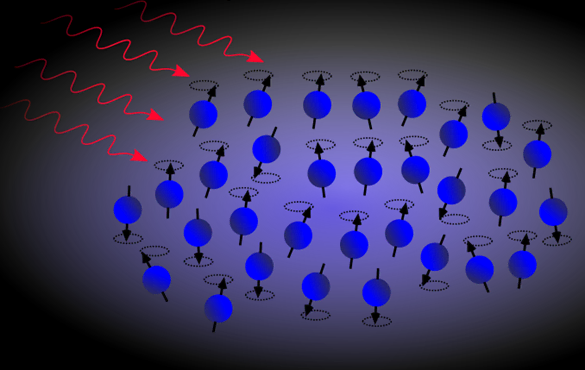Unlocking dynamic information in complex systems
Jr-Shin Li and collaborators want to determine how the brain network controls circadian rhythm, among other theoretical work

NIH funding will allow the creation of model-based and data-driven methods
With fall in full swing, our bodies naturally adjust to fewer daylight hours thanks to our circadian rhythm. Engineering researchers at Washington University in St. Louis want to determine how the brain network allows this to happen using a system-theoretic and computational approach.
Jr-Shin Li, the Das Family Career Development Distinguished Professor and an applied mathematician in the School of Engineering & Applied Science, has received a four-year, $1.6 million grant from the National Institutes of Health (NIH) to create a unified methodology that helps researchers infer dynamic topology and control spatiotemporal structures of complex networks, for example, the connectivity among the brain network that controls circadian rhythm, an important biological process that manages sleep, body temperature and digestion.
In addition, Li received two grants from the National Science Foundation (NSF) totaling $625,000 to create model-based and data-driven methods for better understanding complex population and networked systems.
With the NIH funding, Li will use biological data derived from experiments performed by collaborators Erik Herzog, a WashU professor of biology, and Istvan Kiss, professor of chemistry at Saint Louis University, to build a framework that enables efficient and reliable inference of information about how the environment, such as changing seasons or changing time zones during travel, changes the circadian rhythm. They seek to overcome a significant mathematical challenge by creating a data-driven approach to decode dynamic network topology representing complex dynamic processes, as well as to understand the interaction of circadian rhythms. The researchers say the results of the work will give new insight into the circadian network and how repeated daily disruptions can reorganize the network and impact behavior.
Kiss builds networks of chemical oscillators — populations of neurons that repeatedly fire together, go silent, then fire together again — that behave like circadian cells. He will create a test bed on which Li can test his algorithms.
"It's still far away from being realistic, but the oscillators can mimic the oscillatory behavior of real cells," Li said. "If everything works in these chemical oscillator networks, we will test it on real circadian cells."
Herzog, who studies the cellular and molecular basis of circadian rhythms in mammals, will test Li's method on circadian cells of mice.
The trio is part of a larger team who have already done some groundwork for this newly funded research. They began several years ago after they received a pilot grant from the Keck Foundation. Since then, they've gone on to test Li's method with an early group of chemical oscillators and with mice. That work was recently published in PNAS.
Li will use a three-year, $325,000 grant from the NSF to develop mathematical tools to sort through a large amount of time-series data from a dynamical system. Li equated this work to dynamic learning.
"In machine learning, it is generally required to have a lot of data — often static data — for an algorithm to output useful information and the performance of the algorithm may be highly sensitive to different data sets of the same sort," Li said. "There could be situations where an algorithm works for a particular data set, but not for another. In this project, we aim to take a rigorous mathematical treatment to look into and resolve these issues."
Li will develop novel data-driven methods for inference and learning of complex dynamical systems. Specifically, inspired by the ideas of geometry and topology and tools of computational algebra, Li will construct principled and computational methods to learn how a dynamical or a networked system propagates in time and to characterize the dynamical modes of this system using its time-series data. In this new research, he seeks to decode the complex dynamics of large-scale nonlinear systems and networks and use this decoding to facilitate the control and computational tasks for these systems.
"If I have a huge amount of data, I want to extract the important information and throw away the unwanted information," Li said. "I want to develop a universal method for simplifying complex data sets so that I can still gain the same amount of information I need from a reduced amount of data. In many cases, more data may not necessarily give you more information."
In parallel with this data-inspired research, Li received another grant from the NSF to conduct theoretical work with co-investigator Shen Zeng, assistant professor of electrical & systems engineering. The three-year, $300,000 grant will allow them to learn how best to control and manipulate population systems, which are prevalent in nature, engineered infrastructure and human society, such as neurons in the brain, power grids, robot swarms or social networks. But it is a daunting task, the researchers said.
"When you try to manipulate such populations, you have many systems, and it's virtually impossible to individually address a particular system," Zeng said. "When we do something like this, every other system in the population receives the same signal. Having to orchestrate this population of a bunch of systems and only having one voice is a very difficult coordination task."
Li and Zeng will build on their preliminary work in ensemble control to build a unified theoretical framework that is able to describe and tackle this set of related problems in populations in a coherent way.
"Our approach is an abstract one that tries to leverage the unified mathematical framework to bring into these vastly different fields," Zeng said. "If we could get insight into the fundamentals, understanding a specific case in one field could develop a strategy that could apply to another."





